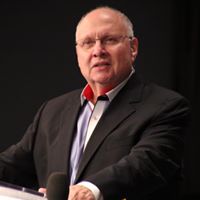By David Freeze
I planned on traveling along N.C. 150 toward Lincolnton and points west on cloudy and rainy Sunday, March 26. I arrived in Lincolnton, county seat of Lincoln County, about 9 a.m. and the same time that a heavy downpour hit the area. I had a new FroggToggs rain jacket and put it to work. Chartered in 1813, Lincolnton was founded on the 1780 Revolutionary War Ramsour’s Mill battle site, a small battle won by the independence forces.
Expecting not much activity, I was pleasantly surprised to find good things happening. The courthouse dominates the historic downtown, with lots of other historic buildings and churches within a few blocks. Several of the churches had services going on, one from a storefront. A farm market store was serving breakfast food as was the Sweet Side Bakery and Café, where I got two of the biggest donuts I’ve seen. One was a blackberry crumble, which really hit the spot. Hailee Jarry, owner, was very welcoming, as I visited my 13th county seat.
Other interesting finds included the Cloninger Rail Trail, 1.7 miles for running, walking and cycling on an asphalt surface. It’s part of the Carolina Thread Trail and passes right under main street, just as the train used to do. Beautiful murals are everywhere, and large pottery is displayed through shopping area. Lincolnton was the site of the first textile mill in the south, and notable buildings include the Lincoln Cultural Center and Emmanuel Lutheran Church.
Back on 150, the next stop was Shelby, seat of Cleveland County. The city was chartered in 1843 and was named for Revolutionary War Hero Isaac Shelby. Considered a textile boom town, Shelby mills paid among the highest wages in the south.
Among the famous locals were singer Don Gibson, bluegrass banjo picker Earl Scruggs and NFL star Bobby Bell. Gibson has an active musical theatre and Scruggs has an ongoing exhibit located in another magnificent and restored courthouse, the centerpiece of Shelby that was built in 1907. Court activities are now held in the Law Enforcement Building, while the restored courthouse also houses a museum.
The next most dominating building is the Charles Hotel, first built in the 1890s. It caught fire in 1928, just ahead of the depression but was able to reopen in 1929. Not currently a hotel, a study is currently underway to possibly restore it again.
Washington Street is a sort of mini-Fulton Street with magnificent older homes, the most famous being Webbley, built in 1852 and once home to NC Governor O. Max Gardner. The city is also home to the American Legion World Series each summer.
Next stop was Columbus, a first time visit for me, and the county seat for Polk County. There’s a historic Columbus and the modern one next to Interstate 26. The courthouse was built in 1855, still in use, and amazingly had open bathrooms on a midday Sunday. In this area, the Civil War divided neighbors as there was some residents remaining loyal to the Union. Four Confederate Companies were formed at the courthouse. Hardships of the war fostered resentment, causing draft evaders and deserters to find refuge in the mountains from where they formed gangs, raided farms and communities. Hard feelings lingered for years.
The town was named after Dr. Columbus J. Mills, considered the “Father of Polk County.” The other major building in town is the former Stearns School building, built in 1917 and used through 1988 with first through 12th grades. The grounds are decorated with library art and a walking trail that follows the pages of the book “Snowmen at Night,” a 2004 children’s book. The historic part of town also has the House of Flags Museum, the only one in the United States, plus a thriving Mexican restaurant and an unlocked foyer of the visitor’s center.
Next came Hendersonville, the county seat of Henderson County. Just a quick drive north on Interstate 26 from Columbus put me on Main Street. Chartered in 1847, the town’s Main Street is well preserved with lots of old buildings that now house restaurants, trendy shopping, boutiques and antique stores.
The Henderson County Courthouse, built in 1905 and completely renovated in 2008, dominates the downtown area and is still in use for some services since the new courthouse was completed in 1995.
Several things I found interesting included many ceramic bear statues along Main Street. I read that the bears mysteriously disappear near the New Year and are replaced by new ones. One building now called the Charleston Inn was built in 1906 with two stories, but a third story was added about 10 years later. Throughout its history, the building had about a half dozen names. The Mast General Store has a Main Street location.
My final destination for the day was Rutherfordton, county seat of Rutherford County. Founded in 1787, it is one of the oldest towns in western North Carolina. Rutherfordton is the site of the first gold mint in the U.S., called the Bechtler mint. Christopher Bechtler made his first gold dollar in 1832, 17 years before the U.S. mint. The Bechtler Mint closed in 1849. Gold dollar replicas are pressed into the downtown sidewalk at various intervals.
Named for Revolutionary War General Griffith Rutherford, Rutherfordton’s Main Street is loaded with historic sites, including another wonderful courthouse, this one built in 1925/26. It has a 75-foot tall Christmas tree, already decorated with lights and a star on top. Same as my windmill. The 1847 St. John’s Episcopal Church looks ready for a small congregation. Two historic houses side by side are called the Carrier Houses and are bed and breakfast locations, one built in 1835 and the other in 1879.
The 13.5-mile Thermal Belt Rail Trail connects Ruth, Rutherfordton, Spindale and Forest City, and is used for walking, running and cycling.
All these towns were active on a Sunday that started rainy and ended sunny. I had 7.95 miles on my feet and 242 on my truck. Seventeen counties down, 83 to go. See you soon with more!







